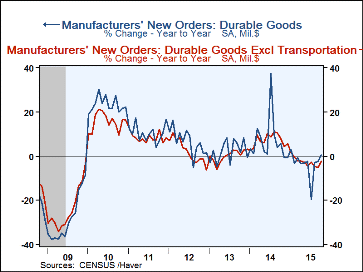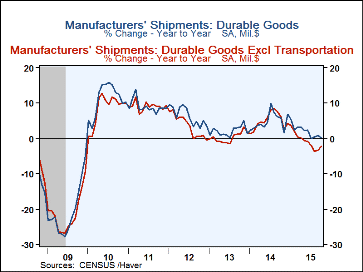 Global| Nov 25 2015
Global| Nov 25 2015Durable Goods Orders Rebound More Strongly Than Expected in October
by:Sandy Batten
|in:Economy in Brief
Summary
Durable goods orders started the third quarter strongly, jumping up 3.0%/m (0.5% y/y) in October against an expectation (Action Economics Forecast Survey) of a 1.5% m/m increase. And the 1.2% m/m decline initially reported for orders [...]
Durable goods orders started the third quarter strongly, jumping up 3.0%/m (0.5% y/y) in October against an expectation (Action Economics Forecast Survey) of a 1.5% m/m increase. And the 1.2% m/m decline initially reported for orders in September was revised up to a 0.8% m/m drop. A 81% m/m surge in nondefense aircraft orders more than accounted for the October increase in overall orders (this was offset slightly by a decline in motor vehicle orders). Excluding orders in the transportation sector, orders rose a more modest, but still larger-than-expected, 0.5% m/m in October (-2.4% y/y) following an upwardly revised 0.1% m/m decline in September.
Especially encouraging was the performance of core capital goods orders (capital goods orders excluding defense and aircraft) in October. They rose 1.3% m/m (0.4% y/y) with the initially reported 0.1% m/m decline in September revised up to a 0.4% m/m increase. With the September revision and October jump, core capital goods orders in October stood more than 6% at an annual rate above the 3Q average, auguring for some further improvement in business capital spending in the fourth quarter. However, the strength in orders has yet to be reflected in actual shipments of capital goods. Core capital goods shipments (a real-time proxy for capex) slipped 0.4% m/m in October (-0.5% y/y) but after an upwardly revised 0.7% m/m rise in September. So, the October level of shipments was about equal to the 3Q average. Hopefully, the rise in capital goods orders will soon translate in increased shipments.
Across the major sectors, apart from the 8.0% m/m increase in transportation orders, overall orders were also lifted by a 1.6% m/m rise in machinery orders and a 1.8% m/m increase in computer orders. Orders for electrical equipment ( 1.1% m/m) exerted the largest drag on overall orders in October.
In other parts of the report, shipments of durable goods fell 1.0% m/m (0.1% y/y) in October following a 0.2% m/m increase in September. Unfilled orders rebounded, rising 0.3% m/m (-2.0% y/y) after a 0.5% m/m fall in September. And inventories slipped 0.2% /m (0.7% y/y), the fifth monthly decline in the past six months.
The durable goods figures are available in Haver's USECON database. The Action Economics consensus forecast figure is in the AS1REPNA database.
| Durable Goods NAICS Classification | Oct | Sep | Aug | Oct Y/Y | 2014 | 2013 | 2012 |
|---|---|---|---|---|---|---|---|
| New Orders (SA, %) | 2.99 | -0.82 | -2.94 | 0.51 | 6.8 | 2.2 | 6.3 |
| Transportation | 8.04 | -2.24 | -6.88 | 6.53 | 6.1 | 6.5 | 16.6 |
| Total Excluding Transportation | 0.53 | -0.11 | -0.85 | -2.37 | 7.2 | 0.1 | 2.0 |
| Nondefense Capital Goods | 13.23 | -6.05 | -4.62 | 3.8 | 6.6 | 2.8 | 10.8 |
| Excluding Aircraft | 1.32 | 0.39 | -1.45 | 0.36 | 6.3 | -1.0 | 7.6 |
| Shipments | -1.02 | 0.24 | -0.50 | 0.09 | 4.8 | 2.0 | 6.3 |
| Inventories | -0.2 | -0.6 | -0.2 | 0.7 | 6.1 | 2.4 | 3.8 |
| Unfilled Orders | 0.3 | -0.5 | -0.3 | -2.1 | 11.4 | 6.4 | 7.5 |
Sandy Batten
AuthorMore in Author Profile »Sandy Batten has more than 30 years of experience analyzing industrial economies and financial markets and a wide range of experience across the financial services sector, government, and academia. Before joining Haver Analytics, Sandy was a Vice President and Senior Economist at Citibank; Senior Credit Market Analyst at CDC Investment Management, Managing Director at Bear Stearns, and Executive Director at JPMorgan. In 2008, Sandy was named the most accurate US forecaster by the National Association for Business Economics. He is a member of the New York Forecasters Club, NABE, and the American Economic Association. Prior to his time in the financial services sector, Sandy was a Research Officer at the Federal Reserve Bank of St. Louis, Senior Staff Economist on the President’s Council of Economic Advisors, Deputy Assistant Secretary for Economic Policy at the US Treasury, and Economist at the International Monetary Fund. Sandy has taught economics at St. Louis University, Denison University, and Muskingun College. He has published numerous peer-reviewed articles in a wide range of academic publications. He has a B.A. in economics from the University of Richmond and a M.A. and Ph.D. in economics from The Ohio State University.










